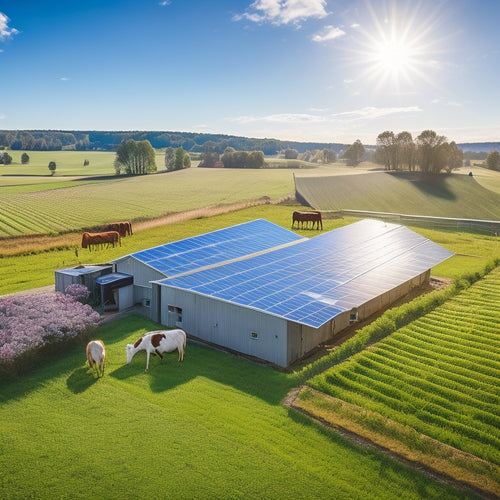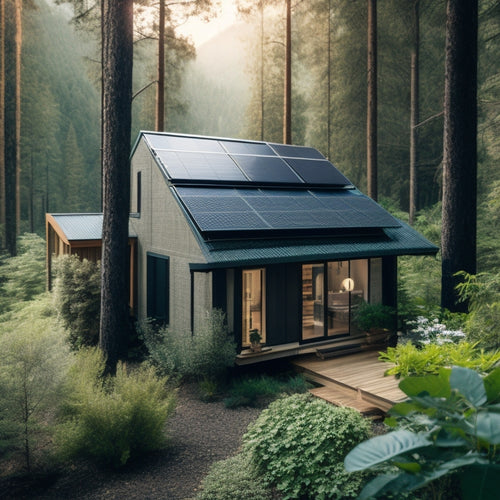
10 Essential Steps to Energy Independence
Share
You're about to take the first step towards energy independence. To get started, assess your daily energy consumption to understand your needs. Choose the right equipment, considering compatibility, efficiency, and quality. Design a solar array that optimizes energy production, and select an ideal inverter that meets your system's needs. Pick the perfect battery, factoring in capacity, environmental impact, and maintenance. Install your solar system, ensuring proper integration and planning for post-installation maintenance. Monitor and maintain performance, ensuring electrical safety and optimizing energy use. By following these essential steps, you'll be well on your way to breaking free from the grid - and there's even more to uncover as you move forward.
Overview
- Assess energy needs by evaluating daily consumption, identifying high-energy appliances, and calculating total energy usage in kilowatt-hours.
- Choose the right equipment by selecting components compatible with existing infrastructure, looking for high-efficiency ratings, and conducting compatibility testing.
- Design a solar array by optimizing panel placement, verifying compliance with local regulations, and assessing grid connection requirements.
- Select an ideal inverter by researching reputable brands, properly sizing it based on system needs, and evaluating features like monitoring capabilities and safety features.
- Plan for energy storage by evaluating battery types, assessing capacity considerations, and researching brand comparisons and technology advancements.
Assess Your Energy Needs
Immerse yourself in evaluating your energy needs by taking stock of your daily energy consumption.
Identify the appliances and devices that consume the most energy and when they're used. This will help you pinpoint peak usage times, which typically occur in the morning and evening when lights, refrigerators, and HVAC systems are running simultaneously.
Calculate your total energy consumption in kilowatt-hours (kWh) to get an accurate depiction of your energy requirements.
Consider creating an energy profile listing device power ratings and daily usage hours to guarantee accurate load calculation.
Analyze your energy usage patterns to determine the minimum and maximum power output you'll need to meet your energy demands.
This assessment will serve as a foundation for achieving energy independence.
Choose the Right Equipment
You'll need to select equipment that's compatible with your system, so make certain you choose components that seamlessly integrate with your existing infrastructure.
Additionally, look for equipment with high efficiency ratings to maximize your energy output.
When evaluating equipment, compare brands and models for quality and reliability, and evaluate durability through material quality, warranties, and maintenance.
System Compatibility
Most renewable energy systems comprise multiple components that must work together seamlessly to generate power efficiently. When choosing the right equipment, you must guarantee system compatibility to avoid costly mistakes.
System integration is vital, as mismatched components can lead to reduced performance, safety issues, or even system failure. Conduct thorough compatibility testing to verify that each component can communicate and function together correctly.
For instance, it's important to confirm that the inverter's capacity can handle the combined array size solar panel selection and avoid efficiency losses. This includes verifying that the inverter is compatible with the solar panels, the charge controller works with the battery bank, and the monitoring system can track the entire system's performance.
Equipment Efficiency Ratings
Your energy independence system's performance relies heavily on the efficiency of its components. When choosing equipment, look for the Energy Star label, which indicates that the product meets energy efficiency standards set by the U.S. Environmental Protection Agency.
Check appliance ratings and efficiency labels to verify they meet performance standards. Conducting energy audits can help you identify areas for improvement and prioritize upgrades.
By selecting efficient equipment, you'll enjoy cost savings and reduce your environmental footprint. Lifecycle assessments can also help you evaluate the long-term benefits of investing in energy-efficient technology.
Stay up-to-date with technology advancements to maximize your system's performance and achieve energy independence.
Off-Grid Capacity Needs
Selecting equipment that meets your off-grid capacity needs is crucial to achieving energy independence. You need to take into account your energy consumption patterns and choose the right solar panel types, backup power solutions, and renewable energy sources. This will guarantee a reliable and sustainable off-grid living experience.
| Category | Considerations | Options |
|---|---|---|
| Solar Panels | Efficiency, durability, cost | Monocrystalline, Polycrystalline, Thin-Film |
| Backup Power | Autonomy, scalability, maintenance | Batteries, Generators, Hybrid Systems |
| Renewable Energy | Environmental impact, energy yield, policy implications | Solar, Wind, Hydro, Geothermal |
Design Your Solar Array
As you move forward with your solar energy system, designing your solar array becomes a critical step in maximizing energy production and guaranteeing a reliable power supply.
You'll need to take into account solar panel placement, considering shading analysis and roof orientation to optimize energy output. Verify compliance with local regulations by obtaining necessary installation permits. If you're connecting to the grid, assess the grid connection requirements.
Aesthetic considerations, such as panel color and array layout, can also impact your design. Don't forget to plan for maintenance access and performance monitoring to ascertain your system runs efficiently.
Select the Ideal Inverter
Now that your solar array design is complete, it's time to focus on the inverter, a vital component that converts DC power from your solar panels into AC power for your home or business.
You'll need to choose from various inverter types, including string, micro, and power optimizers, each with its own benefits and drawbacks. Research reputable inverter brands, such as Enphase, SMA, and Fronius, to guarantee you're getting a high-quality product.
Proper inverter sizing is essential to optimize energy production, so be sure to take into account your system's specific needs. Look for inverter features like monitoring capabilities, remote firmware updates, and built-in safety features.
Also, take into account inverter warranties, installation requirements, and maintenance needs. Finally, evaluate inverter performance, pricing, and compatibility with your system to make an informed decision.
Pick the Perfect Battery
You've finalized your inverter selection, and it's time to focus on the energy storage component - the battery. Choosing the right battery is vital for your energy independence. Here's a brief comparison of popular battery types:
| Battery Type | Capacity Considerations | Environmental Impact |
|---|---|---|
| Lead-Acid | Lower upfront cost, but lower capacity | Higher environmental impact due to lead content |
| Lithium-Ion | Higher upfront cost, but higher capacity | Lower environmental impact, recyclable |
| Nickel-Cadmium | Middle-of-the-road cost and capacity | Moderate environmental impact |
| Sodium-Ion | Lower upfront cost, similar to Lithium-Ion capacity | Lower environmental impact, abundant materials |
| Flow Battery | Higher upfront cost, scalable capacity | Low environmental impact, recyclable |
When selecting a battery, consider maintenance tips, cost analysis, installation techniques, and warranty options. Research brand comparisons and technology advancements to guarantee you're getting the best performance metrics for your energy independence goals.
Plan for Energy Storage
Two key factors to evaluate when planning for energy storage are the depth of discharge (DOD) and the round-trip efficiency of your chosen battery.
These metrics will considerably impact your battery lifespan and overall energy management. You'll want to weigh a battery with a high DOD, as this will allow you to use more of the battery's capacity without reducing its lifespan.
Round-trip efficiency, on the other hand, measures the energy lost during charging and discharging. Look for a battery with high round-trip efficiency to minimize energy waste.
Install Your Solar System
With your energy storage plan in place, it's time to turn your attention to the heart of your energy independence system: the solar array.
You'll need to take into account financing options, local regulations, and the installation timeline. Select a reputable contractor who can guide you through the process, guaranteeing a smooth grid connection.
Before installation, research DIY installation possibilities, but be aware that professional installation may be necessary to guarantee peak performance.
Don't forget to inquire about solar incentives and maintenance tips to maximize your system's efficiency.
By going solar, you'll considerably reduce your environmental impact.
With the right contractor and planning, you'll be generating clean energy in no time, taking an essential step towards energy independence.
Monitor and Maintain Performance
As your solar system begins generating clean energy, it's crucial to keep a close eye on its performance to guarantee ideal energy production and identify potential issues early on. You'll want to establish a performance tracking system to monitor your energy output, ensuring it meets your performance benchmarks. Regular inspections and maintenance schedules will help prevent issues, while troubleshooting techniques will aid in resolving any problems that arise. Efficiency audits and data analysis will provide significant understanding to optimize your system's performance.
| Task | Frequency | Purpose |
|---|---|---|
| System Monitoring | Daily | Identify performance issues |
| Maintenance Schedules | Quarterly | Preventive maintenance |
| Efficiency Audits | Semi-annually | Optimize system performance |
| Data Analysis | Monthly | Track performance benchmarks |
Ensure Electrical Safety
During the installation and operation of your solar system, electrical safety becomes a paramount concern to prevent electrical shocks, fires, and other hazards.
You must verify that your system meets all relevant safety standards and undergoes regular electrical inspections to identify potential risks.
Implement circuit protection, grounding techniques, and surge protection to safeguard your system and appliances.
Confirm load balancing and comply with wiring codes to prevent overheating and electrical fires.
Develop an emergency preparedness plan and perform energy audits to identify areas for improvement.
Additionally, prioritize appliance safety by selecting energy-efficient and certified devices.
Optimize Your Energy Use
You can considerably reduce your reliance on external energy sources by optimizing your energy use.
To start, you'll want to identify and eliminate energy waste in your home or business, ensuring that no power is being squandered.
Next, consider investing in smart home automation systems that can learn your energy usage patterns and make adjustments to optimize your energy consumption.
Reduce Energy Waste
One essential aspect of achieving energy independence is reducing energy waste by optimizing energy use.
You can start by conducting an energy audit to identify areas of inefficiency. Implement behavioral changes, such as turning off lights and appliances when not in use, to reduce energy consumption.
Insulation improvements and appliance upgrades can also make a significant impact. Consider installing smart thermostats and LED lighting to optimize energy use.
Additionally, focus on water conservation and investigate renewable resources to reduce your reliance on non-renewable energy sources.
Smart Home Automation
Smart home automation systems are revolutionizing the way you manage energy consumption, allowing for seamless optimization of energy use.
By integrating smart thermostats and other devices, you can monitor and control your energy usage in real-time. This enables you to make data-driven decisions about energy management, reducing waste and saving you money.
With smart home automation, you can automate routine tasks, such as turning off lights and appliances when not in use, and receive notifications when energy-intensive devices are consuming excessive power.
Frequently Asked Questions
Can I Install Solar Panels on My Old or Damaged Roof?
You'll need a roof inspection to determine if your old or damaged roof is suitable for solar panels; if not, consider installation options like roof repair, replacement, or a ground-mounted system to achieve energy freedom.
Will Energy Independence Affect My Property Value?
You're worried that energy independence will lower your property value, but studies show it can actually increase it; a property value analysis reveals that energy independence benefits, like reduced energy costs, attract buyers and enhance your home's appeal.
Are There Any Government Incentives for Going Off-Grid?
You'll find various government incentives for going off-grid, including tax credits for renewable energy systems, grants for rural areas, and off-grid financing options; additionally, you can benefit from energy storage rebates, making your independence more affordable.
Can I Use My Solar System During a Power Outage?
You can use your solar system during a power outage if you have a solar battery storage system, but with grid-tied systems, you'll need additional equipment to safely isolate your solar power from the grid.
Do I Need to Notify My Utility Company of My Solar Installation?
Imagine flipping a switch to capture the sun's power, but don't forget to notify your utility company of your solar installation, as grid connection requires adherence to utility regulations, ensuring a safe and compliant energy flow.
Ready to Buy
You've reached the finish line! Following these 10 essential steps is like piecing together a puzzle, and now you've got a complete image of energy independence. Your solar system is up and running, humming along like a well-oiled machine. With your newfound energy freedom, you're in the driver's seat, steering your way to a cleaner, greener future. Stay on track, and you'll be reaping the rewards of renewable energy for years to come.
Related Posts
-

What Do I Need to Know About Farm Solar Panels
When considering farm solar panels, you need to assess costs, benefits, and technical specifics. Initial investment c...
-

Solar Phone Chargers for Camping Essentials
Solar phone chargers are must-haves for your camping essentials, allowing you to stay connected while enjoying nature...
-

Off Grid Solar Batteries
As you shift to off-grid living, you'll rely on high-performance solar batteries to store excess energy generated by ...


